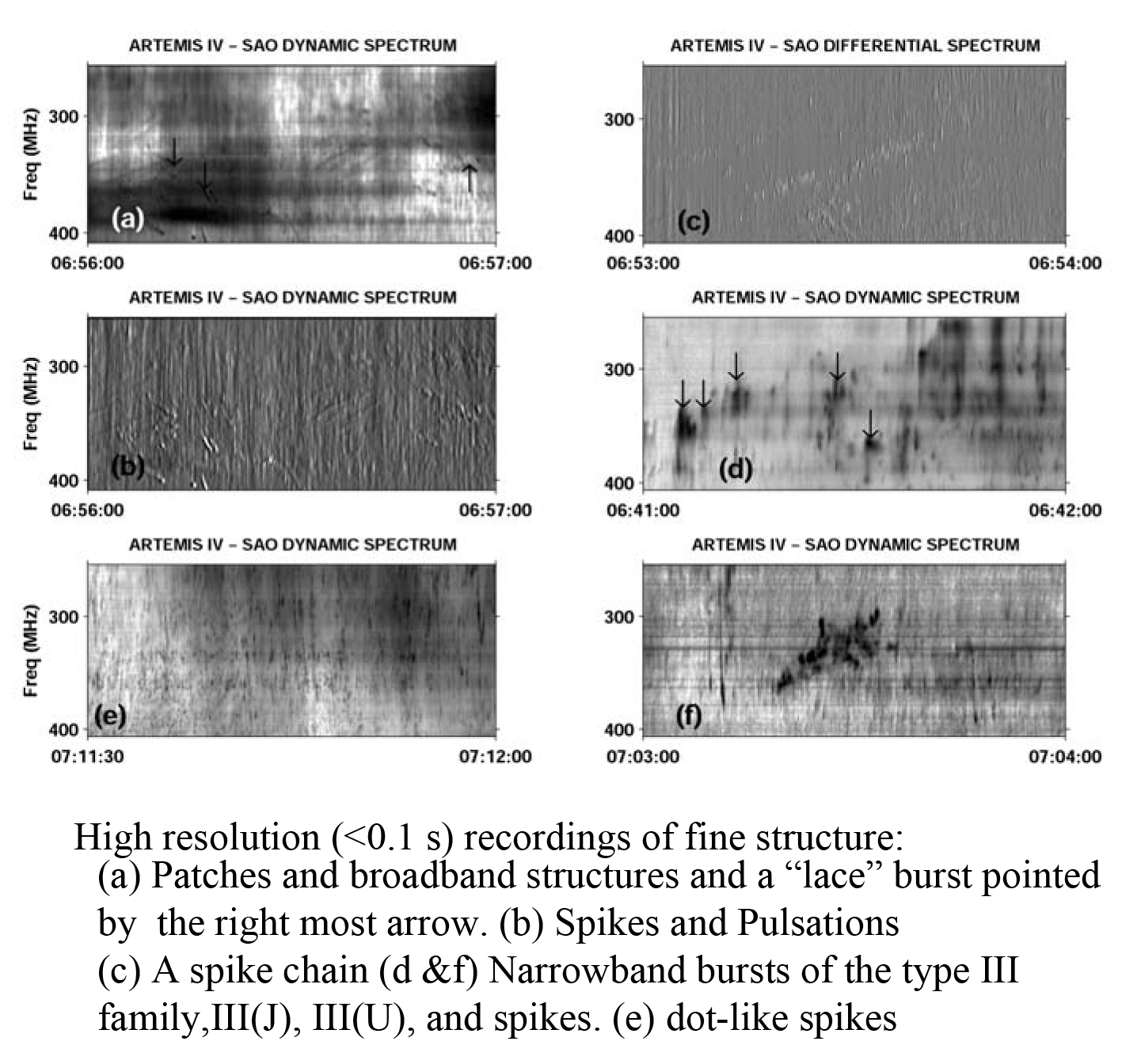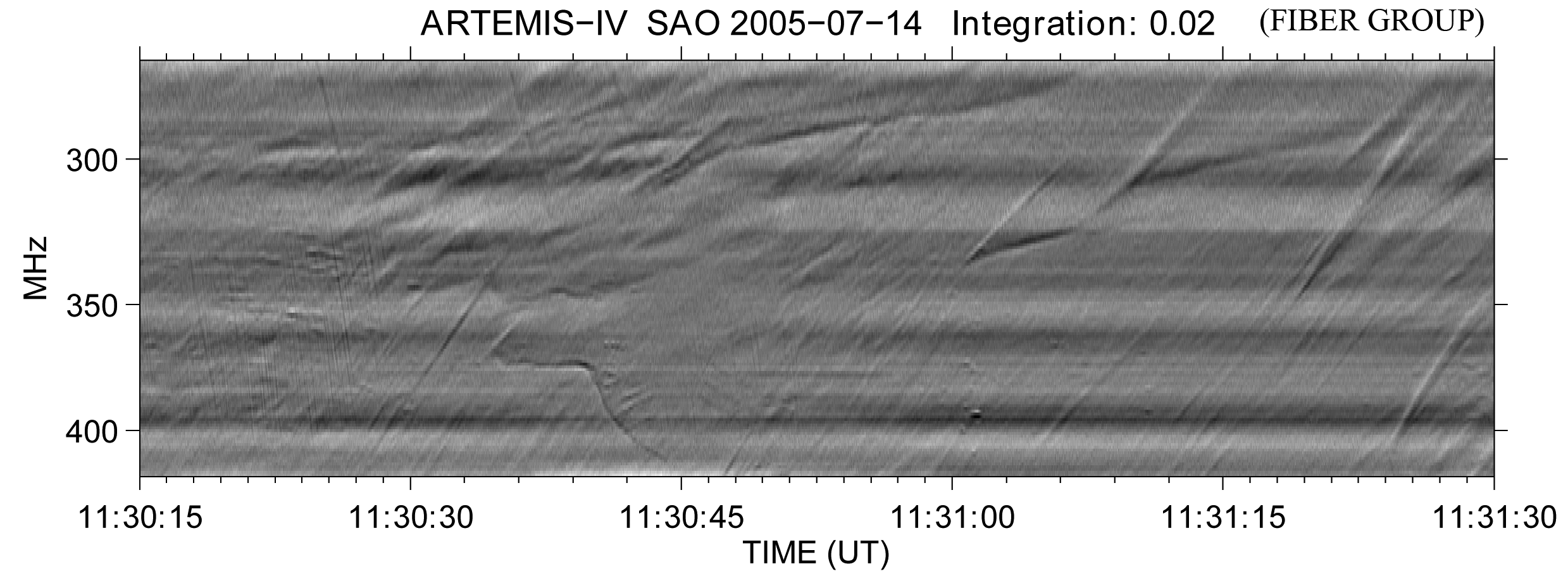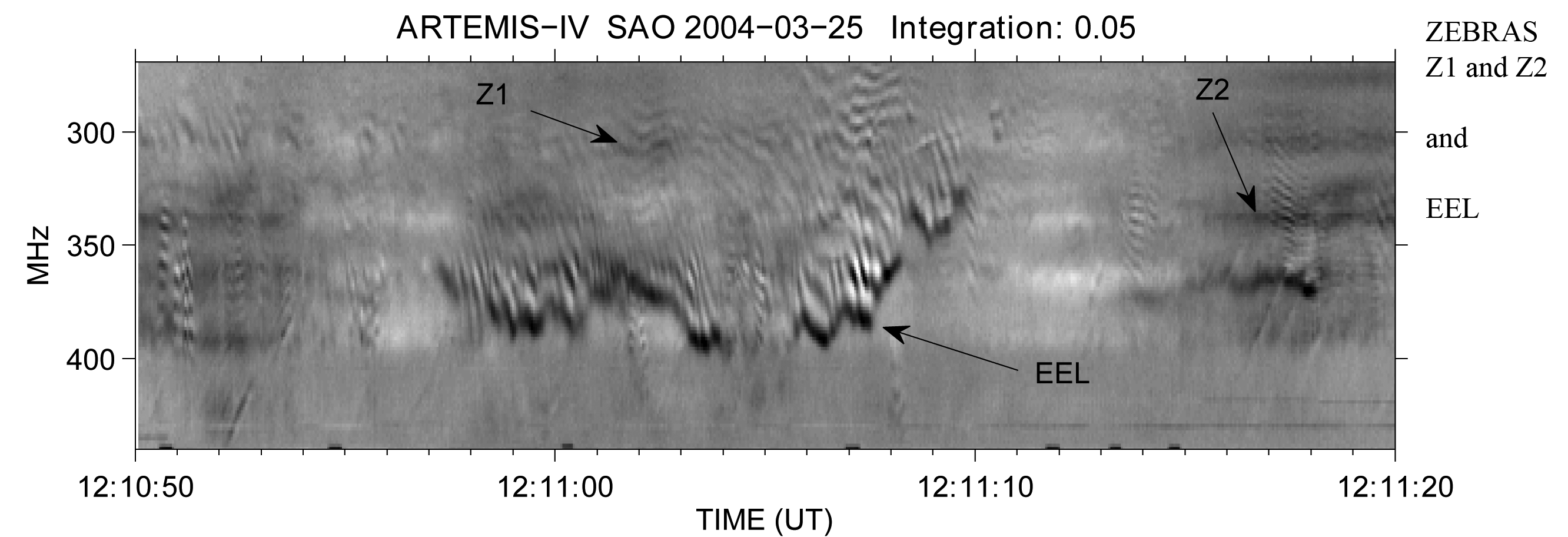Radio bursts provide important diagnostics of energetic phenomena of the Sun. In particular, bursts in decimetric and metric wavelengths probe the physical conditions and the energy release processes in the low corona as well as their association with heliospheric phenomena. The advent of spectral radio data with high time and high frequency resolution has provided a wealth of information on phenomena of short duration and narrow bandwidth. Of particular value are spectral data combined with imaging observations at specific frequencies.
- sun: corona
- sun: radio radiation
- acceleration of particles
- magnetic reconnection
1. Introduction
2. Fine-Structure Classification in the Metric Wavelength Range
2.1. Featureless Broadband or Diffuse Continuum
2.2. Pulsating Structures (Pulsations)

2.3. Narrow-Band Bursts
2.4. Intermediate-Drift Bursts



2.5. Emission Bands



-
A single-emission band, designated as evolving emission line (EEL), first reported by Chernov et al. [44] in the 350–450 MHz frequency range, at the low-frequency cutoff of a pulsating structure, and by Fu et al. [20] and Ning et al. [45] in the GHz range is included in this class, although the emission mechanism appears to be somewhat different from the zebras. After Chernov et al. [44], the observed EEL was the result of electrostatic maser at double plasma resonance.
-
Some “serpentine” single-emission bands recorded in the ∼5 GHz frequency and designated as a “quasi-periodic drifting” structure ([20], Figure 9), or “M-shaped structure” (, Figure 3) may be classified, either as emission bands or as narrow-band bursts of the type-III family (M-Bursts).
-
A structure detected at about 1416–1420 MHz by Oberoi et al.[46] . It consists of a group of short 2–4 ms parallel stripes with a relative delay with decreasing frequency. The total duration of the group is about 16 ms. Due to the band structure, this burst may be considered as a group of emission bands; the short time scale and frequency bandwidth of these bands, however, show some similarity of this burst to narrow-band burst chains.
3. Summary & Discussion of the Classification Scheme
Most of the fine-structure classification efforts have been based on morphological criteria derived from dynamic spectra, with the scheme presented in this entry being no exception.
It was based on observations in metric wavelengths but introduced a novel two-level classification approach was adopted, which comprised a first level of five categories based on coarse spectral features and a second level with two or more subcategories based on the finer details of the features as already mentioned in Section 2. The five basic categories
were also, found to be statistically associated with the phases of the associated flare/CME evolution and the energy release process.
The basic limitation of this scheme, and all previous, is that ephasizes more the morphology that the underlying physical and radiation processes remains. Under the circumstaces certain subclasses, or even classes, may include bursts that are morphologically similar yet originate from different processes. Yet, regardless of these limitations, a classification scheme is still needed as a background for theoretical work
This entry is adapted from the peer-reviewed paper 10.3390/universe9100442
References
- Simnett, G.M.; Benz, A.O. The role of metric and decimetric radio emission in the understanding of solar flares. Astron. Astrophys. 1986, 165, 227–234.
- Klein, K.L. Energetic electrons in impulsive solar flares: Radio diagnostics. Adv. Space Res. 2005, 35, 1759–1768.
- Huang, J.; Yan, Y.H.; Liu, Y.Y. A Study of Solar Radio Bursts with Fine Structures during Flare/CME Events. Sol. Phys. 2008, 253, 143–160.
- Morosan, D.E.; Kumari, A.; Kilpua, E.K.J.; Hamini, A. Moving solar radio bursts and their association with coronal mass ejections. Astron. Astrophys. 2021, 647, L12.
- Aurass, H. Signatures of magnetic reconnection in solar radio observations? Adv. Space Res. 2007, 39, 1407–1414.
- Pick, M.; Vilmer, N. Sixty-five years of solar radioastronomy: Flares, coronal mass ejections and Sun Earth connection. Astron. Astrophys. Rev. 2008, 16, 1–153.
- Nindos, A.; Aurass, H.; Klein, K.L.; Trottet, G. Radio Emission of Flares and Coronal Mass Ejections. Invited Review. Sol. Phys. 2008, 253, 3–41.
- Kouloumvakos, A.; Nindos, A.; Valtonen, E.; Alissandrakis, C.E.; Malandraki, O.; Tsitsipis, P.; Kontogeorgos, A.; Moussas, X.; Hillaris, A. Properties of solar energetic particle events inferred from their associated radio emission. Astron. Astrophys. 2015, 580, A80.
- Miteva, R.; Samwel, S.W.; Zabunov, S. Solar Radio Bursts Associated with In Situ Detected Energetic Electrons in Solar Cycles 23 and 24. Universe 2022, 8, 275.
- Klein, K.L.; Musset, S.; Vilmer, N.; Briand, C.; Krucker, S.; Francesco Battaglia, A.; Dresing, N.; Palmroos, C.; Gary, D.E. The relativistic solar particle event on 28 October 2021: Evidence of particle acceleration within and escape from the solar corona. Astron. Astrophys. 2022, 663, A173.
- Chernov, G.P. Fine Structure of Solar Radio Bursts; Springer: Berlin/Heidelberg, Germany, 2011; pp. Vol 375.
- Benz, A.O. Radio Diagnostics of Flare Energy Release. In Energy Conversion and Particle Acceleration in the Solar Corona; Lecture Notes in Physics Series; Klein, L., Ed.; Springer: Berlin, Germany, 2003; Volume 612, pp. 80–95.
- Nindos, A.; Aurass, H. Pulsating Solar Radio Emission. In The High Energy Solar Corona: Waves, Eruptions, Particles; Lecture Notes in Physics Series; Klein, K.-L., MacKinnon, A.L., Eds.; Springer: Berlin, Germany, 2007; Volume 725, pp. 251–277.
- Bernold, T. A catalogue of fine structures in type IV solar radio bursts. Astron. Astrophys. Suppl. Ser. 1980, 42, 43–58.
- Slottje, C. Atlas of Fine Structures of Dynamic Spectra of Solar Type IV-dm and Some Type II Radio Bursts. Ph.D. Dissertation, Utrecht Observatory, Utrecht, The Netherlands, 1981.
- Guedel, M.; Benz, A.O. A catalogue of decimetric solar flare radio emission. Astron. Astrophys. Suppl. Ser. 1988, 75, 243–259.
- Isliker, H.; Benz, A.O. Catalogue of 1–3 GHz solar flare radio emission. Astron. Astrophys. Suppl. Ser. 1994, 104, 145–160.
- Allaart, M.A.F.; van Nieuwkoop, J.; Slottje, C.; Sondaar, L.H. Fine structure in solar microwave bursts. Sol. Phys. 1990, 130, 183–199.
- Jiřička, K.; Karlický, M.; Mészárosová, H.; Snížek, V. Global statistics of 0.8–2.0 GHz radio bursts and fine structures observed during 1992-2000 by the Ondřejov radiospectrograph. Astron. Astrophys. 2001, 375, 243–250.
- Fu, Q.J.; Yan, Y.H.; Liu, Y.Y.; Wang, M.; Wang, S.J. A New Catalogue of Fine Structures Superimposed on Solar Microwave Bursts. Chin. J. Astron. Astrophys. 2004, 4, 176–188.
- Bouratzis, C.; Hillaris, A.; Alissandrakis, C.E.; Preka-Papadema, P.; Moussas, X.; Caroubalos, C.; Tsitsipis, P.; Kontogeorgos, A. Fine Structure of Metric Type IV Radio Bursts Observed with the ARTEMIS-IV Radio-Spectrograph: Association with Flares and Coronal Mass Ejections. Sol. Phys. 2015, 290, 219–286.
- C. Caroubalos; D. Maroulis; N. Patavalis; J.-L. Bougeret; G. Dumas; C. Perche; C. Alissandrakis; A. Hillaris; X. Moussas; P. Preka-Papadema; et al. The New Multichannel Radiospectrograph ARTEMIS-IV/HECATE, of the University of Athens. Exp. Astron. 2001, 11, 23-32, .
- Benz, A.O. Decimeter Burst Emission and Particle Acceleration. In Solar and Space Weather Radiophysics; Gary, D.E., Keller, C.U., Eds.; Astrophysics and Space Science Library Series; Springer: Berlin/Heidelberg, Germany, 2004; Volume 314, p. 203.
- Bouratzis, C.; Preka-Papadema, P.; Hillaris, A.; Tsitsipis, P.; Kontogeorgos, A.; Kurt, V.G.; Moussas, X. Radio Observations of the 20 January 2005 X-class Flare. Sol. Phys. 2010, 267, 343–359.
- Magdalenić, J.; Vršnak, B.; Zlobec, P.; Hillaris, A.; Messerotti, M. Classification and Properties of Supershort Solar Radio Bursts. Astrophys. J. Lett. 2006, 642, L77–L80.
- Elgaroy, E.O. Solar Noise Storms; Pergamon Press: Oxford, UK, 1977; Volume 90, ISBN 0-08-021039-2.
- Benz, A.O. 4.1.2.8 Radio bursts of the non-thermal Sun. In Solar System, Landolt Börnstein- Group VI Astronomy and Astrophysics, Volume 4B; Springer: Berlin/Heidelberg, Germany, 2009; p. 189.
- Elgarøy, Ø. Intermediate drift bursts. In Proceedings of the CESRA-3, Committee of European Solar Radio Astronomers, Bordeaux, France, 21–22 September 1972; Delannoy, J., Poumeyrol, F., Eds.; Volume 3, p. 174.
- Kuijpers, J. Generation of intermediate drift bursts in solar type IV radio continua through coupling of whistlers and Langmuir waves. Sol. Phys. 1975, 44, 173–193.
- Kuijpers, J. Theory of type IV DM bursts. In Radio Physics of the Sun; Kundu, M.R., Gergely, T.E., Eds.; IAU Symposium; Springer: Berlin/Heidelberg, Germany, 1980; Volume 86, pp. 341–360.
- Aurass, H.; Rausche, G.; Mann, G.; Hofmann, A. Fiber bursts as 3D coronal magnetic field probe in postflare loops. Astron. Astrophys. 2005, 435, 1137–1148.
- Mann, G.; Baumgaertel, K.; Chernov, G.P.; Karlicky, M. Interpretation of a special fine structure in type IV solar radio bursts. Sol. Phys. 1989, 120, 383–391.
- Chernov, G.P. Whistlers in the solar corona and their relevance to fine structures of type IV radio emission. Sol. Phys. 1990, 130, 75–82.
- Chernov, G.P. Solar Radio Bursts with Drifting Stripes in Emission and Absorption. Space Sci. Rev. 2006, 127, 195–326.
- Chernov, G.P. Unusual stripes in emission and absorption in solar radio bursts: Ropes of fibers in the meter wave band. Astron. Lett. 2008, 34, 486–499.
- Alissandrakis, C.E.; Gary, D.E. Radio Measurements of the Magnetic field in the Solar Chromosphere and the Corona. Front. Astron. Space Sci. 2021, 7, 77.
- Tan, B. Diagnostic Functions of Solar Coronal Magnetic Fields from Radio Observations. Res. Astron. Astrophys. 2022, 22, 072001.
- Ni, S.; Chen, Y.; Li, C.; Sun, J.; Ning, H.; Zhang, Z.; An alternative form of the fundamental plasma emission through the coalescence of Z-mode waves with whistlers.. Phys. Plasmas 2021, 28, 040701, .
- Zlotnik, E.Y.; Zaitsev, V.V.; Aurass, H.; Mann, G.; Hofmann, A. Solar type IV burst spectral fine structures. II. Source model. Astron. Astrophys. 2003, 410, 1011–1022.
- Aurass, H.; Klein, K.L.; Zlotnik, E.Y.; Zaitsev, V.V. Solar type IV burst spectral fine structures. I. Observations. Astron. Astrophys. 2003, 410, 1001–1010.
- Karlický, M.; Bárta, M.; Jiřička, K.; Mészárosová, H.; Sawant, H.S.; Fernandes, F.C.R.; Cecatto, J.R. Radio bursts with rapid frequency variations - Lace bursts. Astron. Astrophys. 2001, 375, 638–642.
- Fernandes, F.C.R.; Sawant, H.S.; Cecatto, J.R.; Krishan, V.; Karlický, M.; Rosa, R.R. Evidence of Plasma Resonance Instability from Observations of Solar Decimetric Fine Structures. Braz. J. Phys. 2003, 33, 109–114.
- Chen, B.; Bastian, T.S.; Gary, D.E.; Jing, J. Spatially and Spectrally Resolved Observations of a Zebra Pattern in a Solar Decimetric Radio Burst. Astrophys. J. 2011, 736, 64.
- Chernov, G.P.; Markeev, A.K.; Poquerusse, M.; Bougeret, J.L.; Klein, K.L.; Mann, G.; Aurass, H.; Aschwanden, M.J. New features in type IV solar radio emission: Combined effects of plasma wave resonances and MHD waves. Astron. Astrophys. 1998, 334, 314–324.
- Ning, Z.; Wu, H.; Xu, F.; Meng, X. High-Frequency Evolving Emission Lines for the 25 August 1999 Solar Flare. Sol. Phys. 2008, 250, 107–113.
- Oberoi, D., Evarts, E.R. & Rogers, A.E.E.; High Temporal and Spectral Resolution Interferometric Observations of Unusual Solar Radio Bursts. . Sol Phys 2009, 260, 389–400, .
